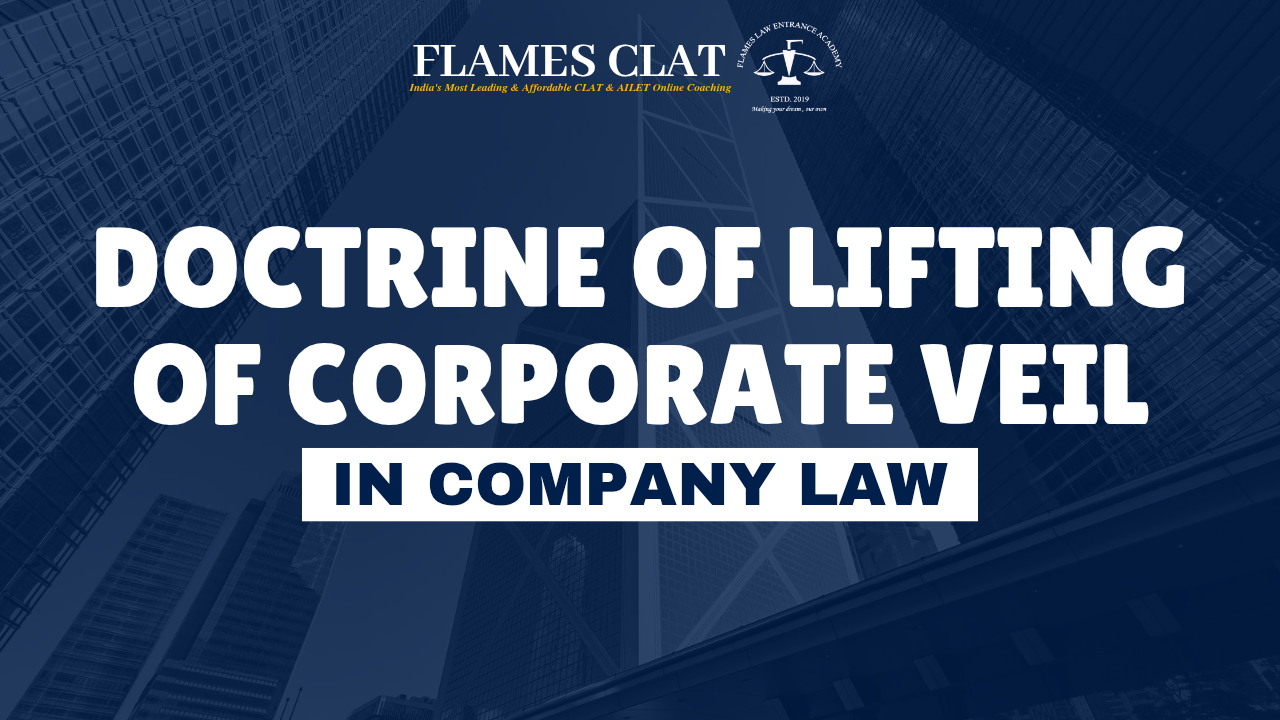Doctrine of lifting of Corporate Veil in Company law
Section 2(20) of the Companies Act, 2013 defines a company as any entity registered under this Act or earlier laws. In simple terms, a company is a separate legal unit formed when individuals come together for a common business purpose. What sets it apart is that it has its own identity distinct from its owners or members. This means it can own assets, enter into contracts, sue others, or be sued in its own name, just like an individual.
What is a Corporate Veil?
The corporate veil is like a legal shield that separates a company from the people who own or run it. This means the company is treated as its own person in the eyes of the law. So, if anything goes wrong in the business like a customer complaint or financial loss—it is the company that is held responsible, not the owner.
Business owners use this setup to take risks and run their company without worrying that they’ll lose their personal savings or property if the business fails. If the company makes a mistake or causes harm, it must fix the problem using its own money or assets not the owner's.
This protection is what the "corporate veil" provides. The owner stays behind this veil and deals with others using the company’s name. Their personal identity and finances stay hidden and safe unless there’s fraud or wrongdoing, in which case the court can "lift" this veil and hold them personally responsible.
What Does “Lifting the Veil” Mean?
While the idea of the corporate veil protects honest business owners from being personally liable, some people take unfair advantage of it. There are cases where individuals hide behind the company’s name and carry out fraud or wrongful acts for their own personal gain. They do this with the intention of keeping the profits but pushing the blame or liability onto the company. When such misuse is found, the courts have the power to lift the corporate veil and expose the real person behind the wrongdoing.
The Companies Act, 2013 outlines specific situations where lifting the veil is legally allowed. Apart from that, Indian courts have also created strong legal standards through past judgments. For instance, in the case of Delhi Development Authority v. Skipper Construction Co. (1996), the Supreme Court held that the company structure cannot be used as a mask to commit fraud. The law is clear when a company is being misused to deceive, avoid liability, or gain an unfair advantage, the court will look beyond the company name and hold the actual person responsible.
Legality of this doctrine in India
In India, the doctrine of lifting the corporate veil isn’t laid down in just one law or rulebook. Instead, it’s something that has developed over time through real-life court cases and judicial decisions. Basically, when someone misuses a company’s identity like using it to commit fraud, dodge taxes, or avoid legal duties the courts step in. Judges look closely at what’s really going on behind the scenes. If they find that a company is just being used as a cover to hide wrongful actions, they can “lift the veil” and hold the actual people responsible. This isn’t done based on one fixed rule, but by applying fairness and logic in each case. These court judgments then set examples, helping others understand when and how this doctrine can be used in future cases. So, it's the courts and not just laws that breathe life into this concept.
Case Laws related to Doctrine of lifting of corporate veil
Daimler Co. Ltd. v. Continental Tyre and Rubber Co. Ltd
In this case the House of Lords decided to lift the corporate veil to understand who was really behind the company. On closer look, they found that the company was being controlled by enemy nationals during wartime. Allowing it to continue doing business could end up helping the enemy financially, which would clearly go against the country’s public interest. So, the court stepped in and treated the company not just as a separate legal entity, but looked at who was actually running it.
Jyoti Limited v. Kanwaljit Kaur Bhasin
In this case the Supreme Court of India used the principle of lifting the corporate veil to look deeper into a company’s involvement in a particular transaction. The court found that the company had acted in a way that amounted to contempt of court. Since the wrongdoing couldn’t be pinned on just the company name, the court held the individuals behind the company its members personally responsible for their actions.
Re: Dinshaw Maneckjee Petit
In this case, the court lifted the corporate veil because the company was clearly being used as a tool for tax evasion. The Supreme Court observed that the company existed only to help its owner escape taxes, and so the person behind the company was made directly responsible.
State of U.P. v. Renusagar Power Co.
In this landmark case the Supreme Court made it clear that lifting the corporate veil shouldn’t be treated as a routine step. The Court stressed that this principle should only be applied in rare and exceptional situations. It reminded the legal system that while it’s important to uncover wrongdoing when needed, the separate legal identity of a company must still be respected. In short, the courts should strike a careful balance using this tool only when necessary, without undermining the core idea of corporate independence.
Conclusion
After looking at the laws and court rulings discussed earlier, it’s clear that there isn’t a fixed or exhaustive list of situations where the corporate veil should be lifted in India. There’s no single law that lays down exact rules for when and how this principle should be used. Instead, Indian courts have been given broad powers and discretion to decide whether or not to lift the corporate veil in each case.
However, this power must be exercised carefully. If the courts are too quick to apply it, it could harm the independence of companies. But being too lenient could allow wrongdoers to misuse the legal system. So, a balanced approach is needed. While lifting the veil has proven useful in exposing fraud and protecting public interest, it shouldn’t become a regular practice. Even companies have certain fundamental rights under Article 21 of the Constitution, such as the right to life and liberty.
As the Supreme Court clearly stated in Balwant Rai Saluja & Anr. v. Air India Ltd. & Anr., the separate identity of a company must be respected. The court should only lift the veil in situations where it’s obvious that the company is being used as a cover to escape responsibilities. It’s a powerful tool but one that should be used rarely and wisely
Join our Flames CLAT Family at https://t.me/flamesclat
For Informative videos, do check out https://youtube.com/@flamesclat?si=-PqiaRLEjutM-iYj




Write a Review
Your email address will not be published. Required fields are marked *